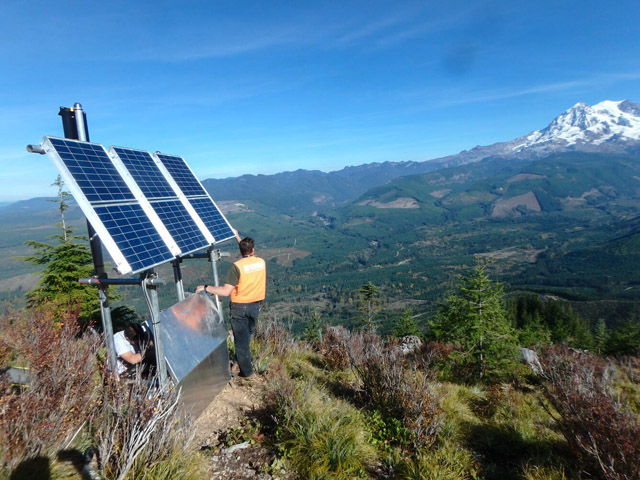2 May 2024–In the shadow of Washington State’s Mount Rainier, about 90,000 people live in the path of a potential large lahar—a destructive, fluid and fast-moving debris flow associated with volcanic slopes.
At the Seismological Society of America (SSA)’s 2024 Annual Meeting, U.S. Geological Survey volcano seismologist Seth Moran described how he and his colleagues have expanded and made upgrades to a detection system that would inform alerts to those living near the Seattle-area volcano in the event of the next lahar.
Volcanic eruptions usually cause lahars by rapidly melting snow and ice. But rarely they can also occur under non-eruptive conditions, such as when the rock underlying a part of the volcanic edifice has been sufficiently weakened by past eruptions and then spontaneously fails, leading to a landslide that can transform into a lahar.
Large Mount Rainier lahars have flowed as far as the Puget Lowlands—about 50 kilometers distance—at least 11 times in the past 6000 years. The largest and most fluid lahars can flow over 100 miles per hour on Mount Rainier’s steep slopes, and as fast as 15 to 20 miles per hour over the Puget Lowlands.
“All of the lahars that have come down into the Puget Lowlands in the last 6000 years have started with an eruption except for the most recent one around 1507,” said Moran. The most recent lahar, known as the Electron Mudflow, appears to have started with a landslide, and researchers have found no evidence of an associated eruption.

The Mount Rainier Lahar Detection System was established in 1998 to give downstream communities tens of minutes of warning on the next large lahar. It consists of tens of seismometers and other instruments placed on the volcano’s slopes and vulnerable lahar paths such as the Puyallup and Tahoma Creek drainages.
The original system “was designed to have low bandwidth and low power requirements due to the limitations of 1990s-era technology, and that meant that data was only transmitted every two minutes,” explained Moran. The seismometer data was paired with a system of tripwires, and both the seismic signals and the tripwire signals had to be triggered over multiple time windows to engage the detection system.
“That meant there was at least four minutes of delay between when the lahar had gone past and when the system said, ‘hey, a lahar has gone past,’” Moran said.
Since 2016, the system has been updated with additional and newer instruments, including broadband seismometers transmitting real-time data continuously, new infrasound sensors, and webcams. Laser range finders are also being tested for possible future inclusion into the detection system as an alternative to tripwires.
There aren’t a lot of examples of lahars around the world that have been recorded on nearby stations, Moran explained, “so we’re not 100 percent certain that we can count on a single type of instrument to tell us what’s going on.”
The diversity of instruments also helps scientists determine whether a seismic signal received from one of the stations is really from a lahar, and not from an eruption or an earthquake. Infrasound instruments, for instance, would be able to tell the researchers that there was a disturbance at ground surface rather than deeper in the earth.
The result of the 20-year technology improvement effort has been a robust lahar detection system that operates in real time, sending detection information to two emergency operations centers that are staffed 24/7, one run by the state of Washington and one run by Pierce County. The operations centers then use the detection report to decide on and deliver a warning.
